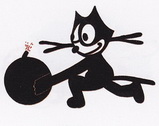|
|
HISTORICAL MINIATURES BY GEORGE GRASSE |
|
|
|
HISTORICAL MINIATURES BY GEORGE GRASSE |
|
|
BOEING F4B-4 (9026), 6-F-12 of VF-6B, USS SARATOGA c. 1935 |
by George Grasse

CLASSIC AIRFRAMES CA4002 1:48 SCALE INJECTION KIT OF THE BOEING F4B-4 c. 1935
|
CLASSIC AIRFRAMES BOEING F4B-4 BOX
ART
|
%20Box%20Art.jpg) |
|
BOEING F4B-4 THREE-VIEW PLAN
|
.jpg) |
| Image credit: United States Navy and Marine Corps Fighters 1918-1962, compiled by Paul R. Matt, edited by Bruce Robertson, Harleyford Publications, published by Aero Publishers, Inc., Fallbrook, CA, 1962. |

|
MODEL TO BE BUILT - BOEING F4B-4
(9026) 6-F-10 of VF-6B, USS SARATOGA c. 1935
|
%206-F-10%20VF-6B%20USS%20Saratoga%201936%20(USN%20Acft%201922-1962%20v.5,%20Listemann,%20p.28).jpg) |
| Photo credit: USN Aircraft 1922-1962 by Phil H. Listemann, Volume 5, page 28 (see Bibliography). |
|
UNDER CONSTRUCTION PHOTO #1
|
|
|
| FUSELAGE GETTING STARTED: The resin parts are from the kit to which have been added solder wire for tubing, white plastic for a small electrical box, and plastic tubing for the fire extinguisher. |
|
UNDER CONSTRUCTION PHOTO #2
|
%2002.jpg) |
| FUSELAGE CONTINUATION: All of the interior has been sprayed to represent the aluminum finish. Details were picked out with semi-gloss black, green, and beige seatbelts. |
|
UNDER CONSTRUCTION PHOTO #3
|
%2003.jpg) |
| FUSELAGE HALVES JOINED: The seams are puttied. When thoroughly dry, they will be sanded down with progressively finer sand paper. Note that this model does not have its 'front deck' installed yet. The 'sister' F4B-4 by Classic Airframes being built at the same time has a complete fuselage in two halves (click here). |
|
UNDER CONSTRUCTION PHOTO #4
|
%2004.jpg) |
| WINGS, TAIL UNIT, UNDERSIDE COMPONENTS: The lower wing is a single piece and fit nicely with the fuel tank covering the joined area. The tail struts wee made from what's left of my old Strutz collection of brass strut material. |
|
UNDER CONSTRUCTION PHOTO #5
|
%2005.jpg) |
| TOP VIEW OF PROGRESS TO DATE: The cockpit is plugged to prevent future painting from marring the inside. If you look closely at the tail unit, the wire support rigging is barely visible - it's made from .005 monofilament thread. |
|
UNDER CONSTRUCTION PHOTO #6
|
|
|
| LANDING GEAR STRUTS: The landing gear struts on each side were cast as individual "V" struts and could not fit properly (note also that I have to correct the alignment). I cut the rear strut off from the main strut. I glued the large front struts to the fuselage and the axle to the struts. After thorough drying, I re-cut the rear struts to fit and glued them in place. The projection on the axle for the wheels was too small and too short. I glued a piece of brass rod along the axis of axle as a substitute. Note that the arrestor hook has been glued to the underside. |
|
UNDER CONSTRUCTION PHOTO #7
|
%2007.jpg) |
| FUSELAGE STRUTS: Note that the struts were pre-drilled for small diameter brass rods to facilitate and strengthen the top wing when it is installed. |
|
UNDER CONSTRUCTION PHOTO #8
|
%2008.jpg) |
| RIGGING AND TOP WING ATTACHMENT: All of the rigging is doubled at all attachment points. Some of the pre-drilled holes for rigging are somewhat visible in this photo and the previous photo. The topside of the bottom wing and the fuselage has had small eyelets glued into the rigging holes. The rigging material (.oo5 MFT) is glued into the holes on the underside of the top wing. These have been pulled aside and taped so as to be out of the way while the struts are glued in place. They will be attached to the bottom wing and fuselage eyelets after the outboard struts are glued. |
|
UNDER CONSTRUCTION PHOTO #9
|
%2009.jpg) |
| MAIN WING STRUTS: The main outer wing struts were fabricated from brass rod and brass tubing. The front and rear struts contain the supporting brass rod. First, each brass rod strut was cut-to-fit. Second, its outer covering was made from slightly pounded brass tubing. When both sides were built, the rod a tube assembly was glued in place. The center cross-over strut was simply another rod and tube piece cut to fit. In all cases, the joint was filled with plastic putty and sanded when dry. The struts were primed in place and then painted. Note that the rigging "wires" are taped off to be out of the way. |
|
UNDER CONSTRUCTION PHOTO #10
|
%2010.jpg) |
| FINISHED: The remainder of the construction process included rigging attachment, decal application, and touch up painting. The tail unit decals were "home-made". The wide black stripe encircling the fuselage and the large chevron on the top wing (not visible in this photo) were hand-painted. All other decals came from Yellow Wings decal sheets. |
|
UNDER CONSTRUCTION PHOTO #11
|
%2011.jpg) |
|
UNDER CONSTRUCTION PHOTO #12
|
%2012.jpg) |
|
UNDER CONSTRUCTION PHOTO #13
|
%2013.jpg) |
|
UNDER CONSTRUCTION PHOTO #14
|
%2014.jpg) |
|
UNDER CONSTRUCTION PHOTO #15
|
%2015.jpg) |
COLOR TABLE
| Naval Gray | Vallejo VC0989 Sky Grey | Fuselage and Struts |
| Aluminum | Vallejo VC0997 Silver | Flying Surfaces except Upper Surface Top Wing |
| Black | Vallejo Semi-gloss Black (Mix) | Section Color (4th of VF-6B) |
| White | Model Master 1768 White | Tail Color (USS Saratoga) |
| Orange Yellow | Tamiya 8034 Camel Yellow 1 | Upper Surface Top Wing Only |
|
1 Sprayed over two light coats of Tamiya 8046 Light Sand |
||
Robertson, Bruce, Editor. United States Navy and Marine Corps Fighters 1918-1962. Fallbrook, CA: Aero Publishers, 1962.
GO TO?